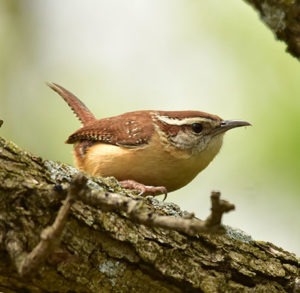The Carolina wren (Thryothorus ludovicianus) is a common visitor to backyards throughout Kentucky and much of the eastern U.S. Both the male and the female look alike. These chestnut-colored, medium-sized, songbirds have a ton of personality and are very vocal.
Although you wouldn’t guess it based on how common they are at bird feeders in the winter, Carolina wrens are primarily insectivores. Most of the plant material they eat is in the winter. Away from bird feeders, you can commonly find them rummaging along the ground picking up leaves and looking for insects hiding in the leaf litter or in rotting logs. They will also pick caterpillars and other insects off branches.

Carolina wrens are unique in many ways. Unlike most songbirds, they mate for life. Even more unusual, genetic testing shows that cheating almost never occurs. In scientific terms, this is called socially and genetically monogamous. Carolina wrens do not migrate and a pair will defend their territory from other Carolina wrens year-round. Most birds don’t maintain their territories during the winter.
Most territory disputes are resolved through songs which means you are likely to hear them before you see them. Studies show that Carolina wrens can recognize the songs of their neighbors and they tend to tolerate neighbors intruding on their territory more than strangers intruding on their territory. Only the male sings. His song is a loud “teakettle, teakettle, teakettle” or “cheeseburger, cheeseburger, cheeseburger.” The female makes a rapid buzzy call and will sometimes insert this call between the male’s song.
Carolina wrens build dome shaped nests made out of sticks, grass, snakeskins, and other natural materials. They will sometimes use birdhouses, but are more likely to build nests in hanging baskets, under porches, in a corner or other undisturbed spot in an open garage, in unused mailboxes, or other similar places. They will often build several nests and then pick one to raise their young.
The female Carolina wren will lay 4-6 eggs and do all of the incubation. The male will feed the incubating female and then both will feed the nestlings. Young Carolina wrens will leave the nest after around a week and a half to two weeks. The adults will continue to feed the young for a short while before beginning a new nest. Carolina wrens typically nest 2-3 times between March and September in Kentucky.
Carolina wrens may not be our most colorful bird, but they make up for what they lack in color with their songs and personality. I, for one, am happy they are one of our familiar backyard wildlife species.

This article was part of Shannon’s original Kentucky Pollinators and Backyard Wildlife blog which evolved into the blog for Backyard Ecology.

Backyard Ecology: Exploring Nature in Your Backyard
Nature isn’t just “out there.” It’s all around us, including right outside our doors. Hi, my name is Shannon Trimboli, and I am the host of Backyard Ecology. I live in southcentral Kentucky and am a wildlife biologist, educator, author, beekeeper, and owner of a nursery specializing in plants for pollinators and wildlife conservation. I invite you to join me as we ignite our curiosity and natural wonder, explore our yards and communities, and improve our local pollinator and wildlife habitat. Learn more or subscribe to my email list at www.backyardecology.net.

Leave a Reply